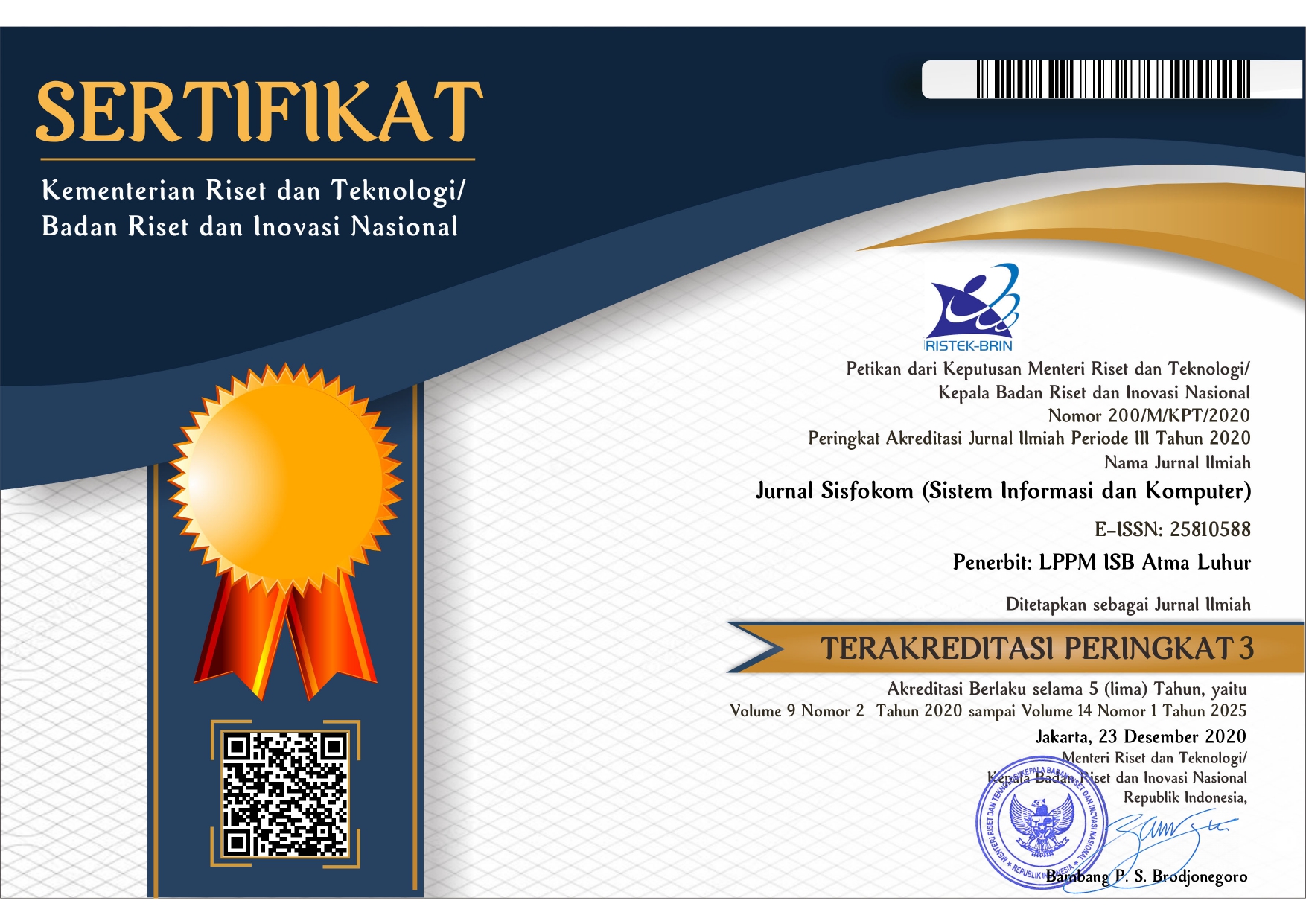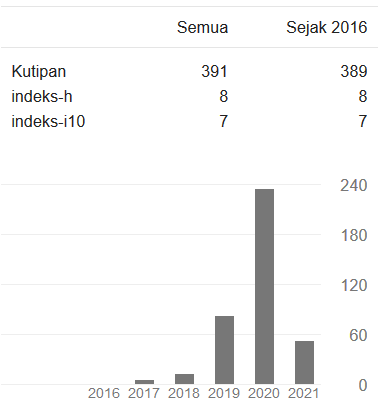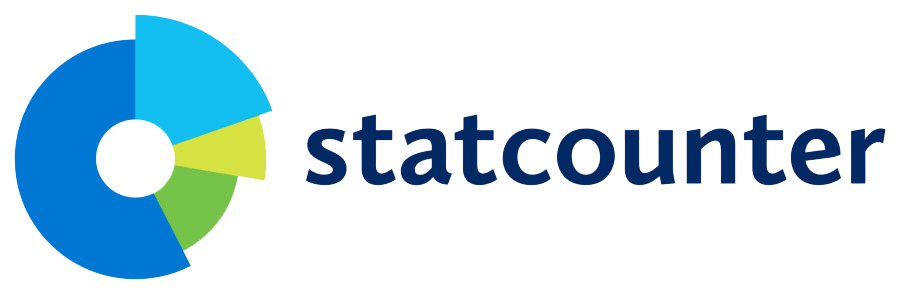Major Recommendation System for New Students at SMK Muhammadiyah 1 Lamongan with Naive Bayes Algorithm
DOI:
https://doi.org/10.32736/sisfokom.v14i3.2390Keywords:
Major Recommendation System, Naive Bayes, Vocational High School Majors, Waterfall Model, Web-basedAbstract
Students' majors in Vocational High Schools (SMK) are very important in determining the direction of their education and career, but the process carried out so far is often subjective and does not consider academic grades and interests objectively. To overcome this, this study develops a website-based major recommendation system at SMK Muhammadiyah 1 Lamongan using the Naive Bayes algorithm that is able to provide accurate major recommendations based on student data. This system is designed using a structured Waterfall Model software development method, starting from needs analysis, design, implementation, to testing. The Naive Bayes algorithm was chosen because of its simplicity and ability to work with relatively small datasets, such as new student data at the school. Of the total 675 student data collected, 60% or 405 data were used as training data to train the Naive Bayes algorithm, while the remaining 40% or 270 data were used as test data to measure the accuracy level of the recommendation system. The test results show that the system achieves an average accuracy of 90.91%, with precision above 0.73 for each major, recall above 0.80 except for the Office Management major which reaches 0.75, and an average F1 score of 81.72%. These findings indicate that the website-based major recommendation system with the Naive Bayes algorithm is effective and can help students determine majors that suit their potential and interests objectively and accurately, thus supporting a more precise and targeted major selection process.References
A. Santika, E. R. Simanjuntak, R. Amalia, and S. R. Kurniasari, “Peran pendidikan sekolah menengah kejuruan dalam memposisikan lulusan siswanya mencari pekerjaan,” Paedagoria J. Kajian, Penelit. dan Pengemb. Kependidikan, vol. 14, no. 1, pp. 84–94, 2023.
A. Mulyana et al., Metode penelitian kualitatif. Penerbit Widina, 2024.
A. Rizka, R. E. Putri, Y. Yusman, and M. Fajar, “Sistem Rekomendasi Jurusan Kuliah dalam Pengambilan Keputusan Menggunakan Metode MOORA,” Kesatria J. Penerapan Sist. Inf. (Komputer dan Manajemen), vol. 4, no. 2, pp. 364–373, 2023.
D. B. Reknadi, M. Munif, and M. Mustain, “Optimasi Layanan KKN: Implementasi e-KKN Berbasis Web Pada Universitas Islam Lamongan,” Kesatria J. Penerapan Sist. Inf. (Komputer dan Manajemen), vol. 5, no. 1, pp. 152–161, 2024.
A. Rohman, A. S. Hidaytullah, and Mg. Rohman, “Implementasi Metode Waterfall pada Rancang Bangun Sistem Pengarsipan Surat Berbasis Website,” Gener. J., vol. 6, no. 2, pp. 134–143, 2022.
A. F. Sitanggang, E. Rasyawir, and L. Aryani, “Klasifikasi Akreditasi Sekolah Di Kota Jambi Menggunakan Metode Na{"i}ve Bayes Di Bpmp Jambi,” J. Inform. Dan Rekayasa Komput., vol. 4, no. 1, pp. 865–873, 2024.
R. R. Sani, Y. A. Pratiwi, S. Winarno, E. D. Udayanti, and F. Alzami, “Analisis Perbandingan Algoritma Naive Bayes Classifier dan Support Vector Machine untuk Klasifikasi Berita Hoax pada Berita Online Indonesia,” J. Masy. Inform., vol. 13, no. 2, pp. 85–98, 2022.
A. Natuzzuhriyyah and N. Nafisah, “Klasifikasi Tingkat Kepuasan Mahasiswa Terhadap Pembelajaran Secara Daring Menggunakan Algoritma Naive Bayes,” Techno Xplore J. Ilmu Komput. Dan Teknol. Inf., vol. 6, no. 2, pp. 61–67, 2021.
H. A. Pratama, “Implementasi algoritma c4. 5 dan naive bayes classification Untuk mengklasifikasi mahasiswa berpotensi drop out,” Fakultas Sains dan Teknologi UIN Syarif HIdayatullah Jakarta.
M. Salehi and I. N. Kamalabadi, “A hybrid recommendation approach based on attributes of products using genetic algorithm and naive Bayes classifier,” Int. J. Bus. Inf. Syst., vol. 13, no. 4, p. 381, 2022, doi: 10.1504/IJBIS.2013.055297.
P. Valdiviezo-Diaz, F. Ortega, E. Cobos, and R. Lara-Cabrera, “A Collaborative Filtering Approach Based on Naïve Bayes Classifier,” IEEE Access, vol. 7, pp. 108581–108592, 2022, doi: 10.1109/ACCESS.2019.2933048.
K. Rrmoku, B. Selimi, and L. Ahmedi, “Application of Trust in Recommender Systems—Utilizing Naive Bayes Classifier,” Computation, vol. 10, no. 1, p. 6, Jan. 2023, doi: 10.3390/computation10010006.
Y. Yulindawati, S. Lailiyah, A. Yusnita, and A. Hafifah, “Rekomendasi Pemilihan Judul Tugas Akhir Menggunakan Metode Naive Bayes,” J. Inf. Syst. Manag., vol. 5, no. 2, pp. 171–175, 2024.
M. Asfi and N. Fitrianingsih, “Implementasi Algoritma Naive Bayes Classifier sebagai Sistem Rekomendasi Pembimbing Skripsi,” InfoTekJar J. Nas. Inform. dan Teknol. Jar, vol. 5, no. 1, p. 44, 2020.
T. D. Salma and Y. S. Nugroho, “Sistem Rekomendasi Pemilihan Sekolah Menengah Tingkat Atas Menggunakan Metode Naive Bayes,” Khazanah Inform. J. Ilmu Komput. dan Inform., vol. 2, no. 2, pp. 85–94, 2016.
M. Ikhsan and others, “Penerapan Text Mining Pada Sistem Rekomendasi Pembimbing Skripsi Mahasiswa Menggunakan Algoritma Naive Bayes Classifier di Program Studi Ilmu Komputer UIN Sumatera Utara Medan,” Indones. J. Comput. Sci., vol. 12, no. 6, 2023.
H. N. F. Fikrillah and D. Kurniadi, “Rekomendasi Pemilihan Program Studi Menggunakan Algoritma Naive Bayes,” J. Algoritm., vol. 20, no. 1, pp. 42–49, 2023.
I. Markoulidakis, G. Kopsiaftis, I. Rallis, and I. Georgoulas, “Multi-class confusion matrix reduction method and its application on net promoter score classification problem,” in Proceedings of the 14th PErvasive technologies related to assistive environments conference, 2021, pp. 412–419.
Downloads
Published
Issue
Section
License
Copyright (c) 2025 Wildan Irsyad Muzaqi, M. Ghofar Rohman, Danang Bagus Reknadi

This work is licensed under a Creative Commons Attribution 4.0 International License.
The copyright of the article that accepted for publication shall be assigned to Jurnal Sisfokom (Sistem Informasi dan Komputer) and LPPM ISB Atma Luhur as the publisher of the journal. Copyright includes the right to reproduce and deliver the article in all form and media, including reprints, photographs, microfilms, and any other similar reproductions, as well as translations.
Jurnal Sisfokom (Sistem Informasi dan Komputer), LPPM ISB Atma Luhur, and the Editors make every effort to ensure that no wrong or misleading data, opinions or statements be published in the journal. In any way, the contents of the articles and advertisements published in Jurnal Sisfokom (Sistem Informasi dan Komputer) are the sole and exclusive responsibility of their respective authors.
Jurnal Sisfokom (Sistem Informasi dan Komputer) has full publishing rights to the published articles. Authors are allowed to distribute articles that have been published by sharing the link or DOI of the article. Authors are allowed to use their articles for legal purposes deemed necessary without the written permission of the journal with the initial publication notification from the Jurnal Sisfokom (Sistem Informasi dan Komputer).
The Copyright Transfer Form can be downloaded [Copyright Transfer Form Jurnal Sisfokom (Sistem Informasi dan Komputer).
This agreement is to be signed by at least one of the authors who have obtained the assent of the co-author(s). After submission of this agreement signed by the corresponding author, changes of authorship or in the order of the authors listed will not be accepted. The copyright form should be signed originally, and send it to the Editorial in the form of scanned document to sisfokom@atmaluhur.ac.id.









